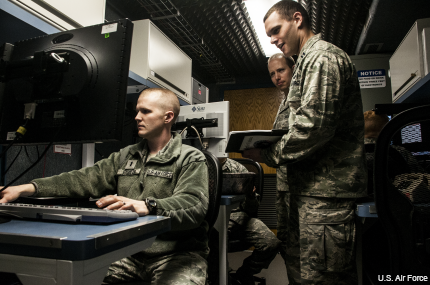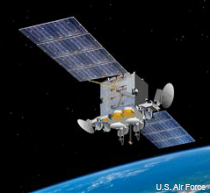Air Force closing in on more powerful satellite comm system
Six months of testing have concluded on the first three satellites in the AEHF constellation, which could soon reach initial operating capability.

Airmen at Schriever Air Force Base, Colo., conduct tests on the AEHF satellites, one of which is pictured in an artist’s rendition below.

The Air Force recently concluded six months of extensive tests on the first three satellites in its Advanced Extremely High Frequency system, which is intended to boost the capacity of secure, global communications for U.S. and allied forces while improving jam-resistance and interoperating with the service’s exiting satellite communications system.
The goals and objectives for AEHF tests were to validate advanced ground mobile units, validate integration to the current Milstar constellation – a five satellite constellation used for communications – confirm communication capability for operators and verify operability under a nuclear environment.
AEHF satellites—there eventually will be six in all—have an immensely increased capacity compared to previous communication satellite infrastructure such as Milstar. According to Air Force officials, a single AEHF satellite has 10 times the capacity as the entire, five-satellite Milstar constellation. For developers, though, AEHF satellites had to demonstrate their interoperability and ability to integrate with Milstar, which was first launched in 1994.
The first AEHF satellite went up in 2010, followed by No. 2 in 2012 and a third in 2013. After on-orbits tests for each individual satellite were completed, officials decided there are now enough AEHF satellites in orbit to assess their capabilities on the ground back on Earth.
Researchers also wanted to ensure the interoperability of AEHF between all military branches and international partners. Personnel were deployed on two Navy destroyers, submarines, three Army locations, two Marine sites, multiple U.S. Strategic Command locations, the United Kingdom, Canada and the Netherlands.
Air Force researchers are still evaluating the results of the tests to ensure they meet the proper national security standards, one of which concerns the ability to operate under high-stress environments such as nuclear threats. "In the event that we go into a nuclear war, we have to make sure a communication link for Department of Defense components and national leadership is available during a contested environment," said Maj. Matthew Collins, AEHF test director at the Air Force Operational Test and Evaluation Center Detachment 4 at Peterson Air Force Base, Colo.
Air Force officials deemed the test a success, and said that, following a review by the Air Force Space Command, AEHF could reach initial operating capability.




